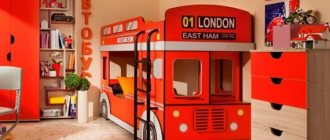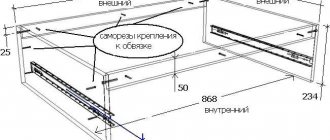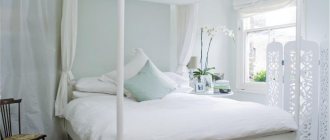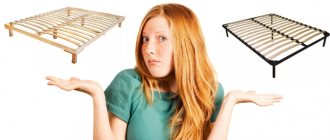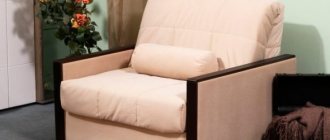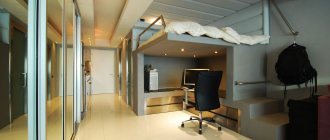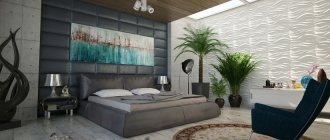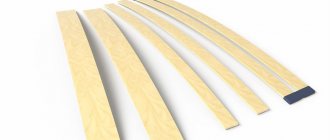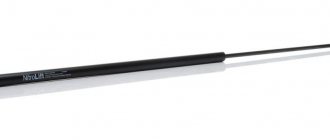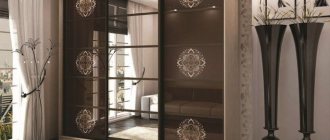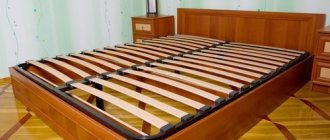Contrary to popular belief, bunk beds are not only suitable for children's rooms; they are an excellent solution in any situation when it comes to saving useful space. This option is optimal for large families, installation in dachas, dormitories, hostels, rest areas for seasonal workers or soldiers. And although wooden furniture will always be out of competition, a metal bunk bed is also quite popular and boasts a considerable number of advantages. The metal structure is very strong and stable, it can withstand heavy loads without deforming, and is characterized by a long service life. The features of such furniture, the rules for choosing and caring for it will be discussed in the article.
Advantages and disadvantages
A metal bunk bed is a functional option that is perfect for residential premises, hotels, country and country houses. The main feature of the product is the location of the sleeping places: they are located on top of each other. This is what makes the design more compact and allows it to be conveniently placed in small rooms.
A two-level metal bed is characterized by a number of positive properties:
- Compactness - the second sleeping place is located at the top, and not on the side, so the furniture takes up a minimum of space, which allows it to be installed in small rooms.
- Functionality - the design is equipped with additional elements: drawers for linen, a table, a chest of drawers.
- Originality - to order, from one frame you can make a bunk bed of the desired design and with any dimensions, even non-standard ones.
- Comfort – the product is manufactured in strict compliance with all standards for bedroom furniture; resting on such a bed is no less comfortable than on the usual “single-story” beds.
- Reasonable cost - purchasing this model will cost less than two single-seat options; there are even budget offers that can fit quite organically into modern design and last a considerable time.
However, do not forget that metal products have certain disadvantages:
- Processing this raw material is a technically complex procedure, so beds are produced in limited quantities, their range is much more modest, especially compared to their wooden counterparts.
- The material has good thermal conductivity, so in summer the furniture will get very hot.
- The metal is susceptible to corrosion; for protection, a special polymer coating must be applied to the surface, which should not be subjected to mechanical stress, otherwise its functionality will be impaired.
- There is a fairly high level of injury risk; impacts on a metal surface (which is not uncommon for little fidgets) will result in bruises, at a minimum.
Important positive properties of a metal structure are a high level of fire safety and hygiene; microbes do not multiply on such a surface.
DIY bunk bed: preparatory stage
When creating a design, accuracy and precision in work are required. Therefore, at the initial stage of manufacturing the product, it is necessary to make a detailed drawing of a bunk bed, which indicates its dimensions and components. For each individual unit, an individual diagram must be made with the exact dimensions of all its components marked. The general drawing shows the assembly diagram of a bunk bed and how to connect all its parts.
Related article:
Bunk bed with sofa: convenience and optimization of space
Photos and features of the device. What materials are used. How to choose the right one. Sofa convertible into a bunk bed.
The mattress is taken as the basis for design calculations. The size of the bed must strictly correspond to its dimensions. A perimeter allowance of 1 cm is allowed. The width of the backs of the structure must correspond to the width of the couch, taking into account the thickness of the longitudinal slats and the size of the overhang. This calculation is carried out for wooden structures. As for metal products, the double thickness of the pipe is added to the width of the bed, taking into account an allowance of 1 cm. The size of the longitudinal slats corresponds to the length of the mattress with an allowance of 1 cm.
Once the model has been determined, the manufacturing material has been selected and all the necessary diagrams and drawings of a bunk bed have been created with your own hands, you should begin manufacturing the component elements. To perform the work, you need to prepare tools.
Drawing of a bunk bed with steps and drawers
If the bed is made of metal, you will need:
- grinder for cutting metal products;
- welding machine;
- drill with a drill for working on metal with a diameter of 9 mm;
- roulette;
- square file;
- metal square;
- sandpaper;
- metal brush;
- paint brush.
To create solid wood bunk beds you will need;
- milling machine;
- grinder or plane;
- hacksaw;
- screwdriver;
- electric jigsaw;
- drill;
- sandpaper;
- roulette;
- level.
Varieties
Manufacturers offer a wide range of bunk beds with metal frames. They differ in design, shape, and design. There are models with additional furniture elements, functional products with a sofa underneath, options for adults and children.
Children's
A metal bunk bed for children is usually chosen for a room with a small area. Among the most popular options for children:
- classic designs with two berths and a high level of safety;
- attic - a two-story model for one child, the bed itself for sleeping is usually located at the top, and below there is a wardrobe and an area for toys;
- bunk bed with drawers and cabinets - looks original, is functional, and provides additional convenience.
Such children's bedroom furniture is a standard compact and practical bed, characterized by durability, mobility, and aesthetic design. Each model is necessarily equipped with protective sides to prevent the child from falling during sleep, and a ladder for comfortable movement to the upper “floor”.
The design should be comfortable and safe. It is worth remembering that children love to play outdoor games, run, jump, so they may accidentally hit themselves. To protect them from injury, it is better to purchase products without sharp corners and with soft upholstery. Don’t forget about the aesthetic component - a bed painted in bright colors with interesting decorative elements is perfect for a child’s room.
Adults
Iron beds for adults with two tiers will also be an excellent solution for small apartments, especially when the children have grown up and the living space remains the same. They are also often installed in guest rooms, country and country houses, hotels, and student dormitories.
Main features of adult beds:
- provide large dimensions, the length can reach 2 m, for some models this parameter is adjusted independently by moving and extending the structure;
- the furniture is massive, strong, resistant to loosening, capable of supporting a weight of 150 kg and even more;
- There are options in which the lower berth can be transformed into a double one.
Users consider a metal bunk bed with a sofa located at the bottom to be unusual and comfortable. The advantage of this option is that, if necessary, this area can be turned into double furniture.
Adult beds vary in size, type of mesh and cross reinforcements. The more expensive the furniture, the more reinforced it is.
Transformers
A metal bunk bed with the ability to transform into other furniture has long gained wide popularity. Among the most popular models:
- The option with a sofa below will significantly save space. Such furniture becomes a place to sit during the day, and at night it becomes a comfortable bed with two tiers.
- In the form of a wardrobe - if necessary, the sleeping place is raised to the wall using a folding mechanism, forming a dummy wardrobe with shelves and mirrors. On the sides there are often drawers, shelves, and cabinets for storing things, clothes, and linen.
- Folding - the design can become horizontally directed. The models use not a frame as a basis, but a body, on two levels of which sleeping places are installed. During the daytime, the structure folds up and forms a closet, and at night it is used as a wide metal bunk bed.
- Pull-out - these options are usually used for children's rooms, they significantly save space; underneath the bed there are drawers in which you can store clothes, linen, and toys.
This or that bed model is selected to suit the individual needs of a person. Many are designed not only for recreation, offering much more advanced functionality.
Folding
With a sofa
With shelves and drawer
With wardrobe
Special purpose
There are also special-purpose metal beds on sale, which consist of two tiers. They have compact sizes, a simple design without decoration, unusual and elaborate shapes.
Options for special-purpose metal two-tier models include:
- beds for cabins;
- beds for workers;
- army beds.
They all differ in the following features:
- simple design without additional elements;
- high strength - special metal wire is used for production, which meets quality standards;
- compact dimensions;
- eliminating the possibility of surface damage by corrosion due to the polymer coating;
- comfortable sleeping place.
In addition, such beds are highly resistant to loosening and additional loads. They are equipped with plates that increase the strength of the products. The main focus when creating such furniture is on practicality, and not on beauty.
For workers
In the change house
Army
How to make your own bunk bed
The assembly of structures made of wood and metal occurs in a similar way.
In the most general form, the order of assembling a bed from finished parts occurs in the following sequence:
- Make 2 boxes according to the dimensions of the drawing
- They provide a shelf, a base for a mattress, and install perpendicular ceilings
- Vertical posts are attached to the lower tier
- The upper tier is attached to the racks at the required height
- Attach headboards on both sides (solid or in the form of separate elements)
- Both tiers are connected by stairs
- Attach protective side panels
- The structure is primed, varnished or painted
Made of wood
The best choice for a wooden bed is pine timber or furniture panels
To make a children's bed for 2 tiers from solid wood, you will need the following blanks, cut to the required dimensions:
- 4 vertical posts
- 4 kings
- 4 side boards for supporting frame
- 4 external covers for racks
- 4 bars for subsequent laying of boards into the base of the frame
- 2 headboards and 2 footboards (with the same parameters)
- 4 boards for mounting the ends
- 24 slats for the base for laying the mattress (12 pieces for each tier)
- 3 elements for steps and 2 for stair railings
- 2 elements for fencing and protection
To assemble a bunk bed from wooden blanks, follow these steps:
1 The side panels (drawbars) are connected to each other with fasteners at an angle of 90 degrees, forming a rectangular box
Attaching shelves to the frame frame
2 The bars are attached to the drawers with self-tapping screws, on which the boards are then placed into the base for the mattress
First, the lower tier is assembled, starting with the frame and slats for the mattress, then all steps are repeated for the second bed
3 Vertical posts equal in height to the entire structure are attached to the box, checking the correctness with the building level
4 Holes are made in the racks with a drill and 3 boards are attached parallel to the floor with dowels to form the back
Bottom frame of a two-story bed with compartments for drawers
5 The upper box is connected in the same way to the vertical posts
6 Using fasteners using the “under-counting” , screw the ladder to the side frames of the body from the outside
The parts are connected using glue, but must be reinforced with self-tapping screws
7 Protective panels are nailed to the side of the upper tier, bypassing the stairs. On the lower tier it is allowed to nail the protective shield on only one side
Stages of assembling a wooden structure step by step
8 Knock down drawers from fiberboard and place them under the lower tier
The finished wooden structure is sanded and varnished
9 The structure is sanded, coated with protective varnish, allowed to dry, and painted if necessary
10 Mattresses of appropriate sizes are placed in the recess of both frames
All elements are attached with glue, self-tapping screws, and reinforced with metal corners. For an attractive and neat appearance, it is recommended that fasteners be placed on the inside of the structure or covered.
Made of metal
Ready-made structure for 2 tiers made of metal
Assembling a metal bed for 2 floors assumes that the builder has the following materials in his arsenal:
- profiles with a section of 50x25 mm for the box
- profiles with a cross section of 20x25 mm for mattress base slats
- metal structural elements with a cross section of 40x40 mm for soldering side posts
Drawing for assembling a two-story children's snowstorm from a metal profile
Next, the assembly process from pre-cut parts goes like this:
- The back elements are welded at an angle of 90 degrees, respectively.
- A base is assembled from a profile of a smaller cross-section, which is welded to the long parts of the lower and upper frames at the same distance from each other
- Vertical slats in pairs connect the backs of two tiers together by welding
- The lower frame is welded at a distance of 30-40 cm from the floor to the racks
- The upper base for the mattress is connected to the slats already at a height of 95-100 cm from the lower one
- A ladder is made from the profiles, which is welded to both floors of the bed in a suitable place.
- The joints are sanded and the structure is painted.
Staircase options and ways to place them
For bunk beds, the following types of staircase locations are provided:
- vertical - represented by two guides, which are installed in the appropriate position, their connection to each other is carried out using special crossbars;
- marching - involves the use of inclined steps; compared to the previous type, its use is much safer, but next to the sleeping area you will need to allocate about 0.5 m2 of free space to install the stairs.
Particular attention should be paid to the placement of this important component of a bunk bed. It should not only be user-friendly, but also secure. For a structure to be stable, it must be made from the highest quality materials.
Marching staircase
Vertical ladder
Recommendations and nuances
A staircase in the form of drawers is one of the safest designs
To ensure that the result – a bunk bed for children’s sleep and rest – is pleasing and lasts for a long time, construction professionals advise taking into account the following nuances:
- To make an attic-type bed from wood, parts of different sections are used. Work begins with assembling the left end element
- A pull-out bed (often used in rest rooms in kindergartens) can be assembled from MDF sheets with a thickness of 19-22 mm
- The wooden structure is fastened using tenons and chops, which are pre-lubricated with wood glue, or using ordinary metal screws
- The backs of the tiers should be made soft to eliminate the risk of the child hitting himself in his sleep.
- For reliability and strength of the structure, both tiers are attached to the wall with metal corners
- A transverse rail is installed in the frame to give the frame rigidity
- Traditionally, a staircase has 3 steps, but sometimes it is advisable to make more steps, and as children grow older, change the distance between the elements
- To give the structure stability, the lower tier is placed on the fifth leg, which is placed in the middle of the transverse beam of the base
- It is preferable to connect wooden parts using an oblique flush joint
- For greater safety, the stairs are made inclined, with railings, and anti-slip pads are glued to the steps
For stability, the two-tier structure is screwed to the wall and “placed” on the fifth leg
Whatever model and design is chosen for self-assembly, the main thing that attention is paid to is the accuracy of calculations and the quality of the materials used . When it comes to assembling children's furniture, the characteristics of safety, reliability and convenience come to the fore.
If you take the measurements correctly and the work itself is careful, then a bunk bed assembled with your own hands will not be inferior in performance characteristics and service life to factory models, and will surpass them in design.
Style solutions
Metal beds of two tiers can fit into almost any interior design, this is facilitated by a variety of style solutions used in the manufacture of such furniture. Among the most popular options:
- classics - models with minimal decor, additional wooden elements, simple and laconic forms, in neutral colors - usually black, white, shades of brown;
- loft – clear lines, discreet colors, beds should fit perfectly into the interior without being conspicuous;
- modern - characterized by smooth forms without sharp transitions, the background is light, and the remaining elements should be dark, it is recommended to select simple designs without rich decor;
- minimalism is a modern interior style, fits harmoniously into strict lines, provides functionality and convenience;
- Provence - such beds are relevant for a summer residence;
- country - a combination of modernity and elements familiar from childhood;
- hi-tech – characterized by a strict style and maximum functionality.
Modern beds are comfortable and attractive in appearance; choosing a suitable solution will not cause difficulties, especially if you listen to the practical advice of furniture experts.
Country
Classical
Loft
Minimalism
Modern
Provence
High tech
Required Tools
Tools needed to assemble a 2-tier bed
When assembling a bunk bed made of wood, MDF, fiberboard, furniture panels, you will need:
- drill with drill bits
- screwdriver
- plane
- countersink
- roulette
- milling machine
- jigsaw
- sandpaper (sanding machine with 120 and 240 grit stones)
- knife
- building level
- fastening elements (dowels)
- simple pencil
- wood glue
Instruments
To work with metal and profiles, add to this list of tools:
- hacksaw and metal drills
- grinder
- file
- screws, metal screws
- metal square
- brush and brush for working with metal
- welding machine
Having chosen the type of surface, purchase varnish, stain, wood or metal paint, and primer.
Criterias of choice
In order for the product to cope 100% with the task assigned to it, to look aesthetically pleasing, and to be safe for health, it is worth considering the mandatory important selection criteria:
- dimensions - width should be at least 70-90 cm, and length - from 190 to 205 cm;
- strength - the bed must be made of high quality metal (preferably aluminum);
- durability - there must be a coating on top that will protect the product from corrosion, in addition, it must be free of chips and scratches;
- stability - solid rather than collapsible structures are preferred;
- safety - it is necessary to have protective sides and a reliable, durable, stable staircase, ideally with flat steps;
- easy maintenance - it should be enough to wipe the metal case with a damp cloth to get rid of dust.
The advantage is the presence of additional elements. This is an orthopedic base, curtains, shelves, mattresses. They provide convenience and increase functionality.
What materials can a bunk bed be made from?
To make a bed, you can use natural wood, metal or wood-containing materials. The most durable of all options is metal. To make a bed, straight-seam thin-walled pipes, round bars or wire made of brass, iron, galvanized metal or carbon steel can be used.
Finished products have an aesthetic appearance and can withstand heavy weight. The disadvantages of the material include the labor-intensive manufacturing process, which requires the use of a welding machine, and the high cost of the structure.
Solid wood is a difficult and expensive material to process. When working with it, you must have good skills in working with wood so as not to damage the products. However, the result is a solid wood bunk bed that is strong, reliable, durable and presentable.
Solid wood is an expensive material, but a bed made from it will last a long time
Planed or edged boards are often used for the manufacture of structures, since this is the most economical and easiest to implement option. If designed correctly, such a structure can even support an adult.
Important! To create a strong and stable structure, it is important to purchase a well-dried board that will not subsequently deform.
An affordable option is MDF. Bunk beds made from this material are beautiful and durable. However, an MDF product may break under heavy loads. This material is advisable to use for beds intended for small children, and you can also make backrests, drawers, shelves or decorative panels from it. For the same purposes, laminated chipboard is suitable, which also does not have a large load-bearing capacity.
Important! If laminated chipboard is used to create a bed frame or sleeping place, a sufficient number of supporting elements should be provided.
MDF is the most popular and cheapest material for making a bunk bed
Furniture board is a durable, strong and reliable material. It is represented by a slab that is glued together from different blocks of natural wood. This is an ideal material for making bunk beds because it has a high load-bearing capacity. When working with a slab, it should be taken into account that it has internal tension.
How to fit into the interior
A metal bunk bed should fit harmoniously into the overall style of the interior and fit perfectly with other elements of furniture. To ensure that the design does not stand out against the general background, it is worth considering a few important tips. So, in a bright room with minimal decoration, a simple bed in a neutral color would look appropriate. Bright designs are inappropriate here; they will become an “absurd spot” in a classic interior. Unusual options with a variety of shapes and patterns, and beautiful decorative elements are suitable for children's rooms . If they are supplemented with drawers, cabinets, which can be made in the form of animals, cars, palaces, this will only be a plus for the child. For a living room that is decorated in bright colors, you can use a bunk bed with colorful decor.
Metal bed models are an ideal solution for interiors designed in high-tech and minimalist styles.
How to choose
The criteria for choosing a metal bunk bed depend on your goals. If you choose it for children, then the criteria should be more clear and strictly observed. We can only give general recommendations for selection.
- Give preference to aluminum. It is not subject to corrosion like steel, and the product will last much longer.
- Check the coating carefully. There should be no scratches or chips on it;
- sustainability. It is better to choose a non-separable model. If you are the owner of a collapsible one, then pay attention to the connection mechanisms: they should be convenient and simple.
- For children, choose beds with high sides and flat steps on the stairs.
- Reliable sleeping furniture will last a long time and will become a favorite corner for more than one generation.
Its appearance allows it to be used in any interior, both for adults and children.
This is especially important in children's rooms, because kids can play too much, get spoiled and try to break the furniture.
This is especially important when there is a child in the house.
Not subject to rot.
Metal is a bad environment for the development of microorganisms.
Care Tips
To make the bed look decent, you need to regularly wipe off dust and dirt from its surface with a damp cloth or sponge. From time to time it is worth using special pastes and solutions for metal products that protect the surface from corrosion. It is important to ensure that the composition does not contain abrasive substances that can scratch the coating or thin it, which will inevitably lead to rust.
For metal furniture, there are also special wipes containing wax. Their regular use will repel moisture from the surface, provide complete protection and care, and add a glossy shine to the coating. Scratches on such surfaces are polished; tooth powder, chalk or flannel with chrome-plated are suitable for this purpose. Darkening is removed with ammonia or lemon, after which the bed is wiped with soapy water and polished with a soft cloth.
Compliance with these simple rules will help significantly extend the life of the furniture, without losing its attractive appearance and functionality.
Flaws
Metal 2 bunk beds have several disadvantages that are directly related to the material used. Let's look at them in more detail:
- Any metal conducts heat very well and heats up. However, it is not capable of storing heat. By checking the structure by touch, you can make sure that it always remains cold. Manufacturers sometimes use a special coating designed to retain heat, but, as a rule, such beds are quite expensive.
- Steel can corrode and rust quickly. Only aluminum structures do not have this disadvantage. In order to preserve the attractive appearance of the bed for as long as possible, all parts must be treated with a protective polymer agent. Unfortunately, regular powder coating is less durable.
- Unlike wooden ones, metal structures have more modest equipment. Most often, this is a simple sleeping area, without a work or sports area.
IKEA (IKEA) TROMSO
Most modern metal beds are lightweight. To manufacture the structure, modern manufacturers use steel pipes that are hollow inside, which greatly facilitates the design.
For a family in which there is more than one child, you can consider fashionable pull-out children's beds for two children. They will save space in the room and become a real highlight in the interior.
"Granada"
